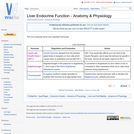
Table showing the important hormones produced by the liver
- Subject:
- Anatomy/Physiology
- Life Science
- Material Type:
- Diagram/Illustration
- Reading
- Provider:
- WikiVet
- Provider Set:
- Anatomy & Physiology
- Date Added:
- 02/05/2015

Table showing the important hormones produced by the liver

The lungs are the site for gaseous exchange, and are situated within the thoracic cavity. They occupy approximately 5% of the body volume in mammals when relaxed, and their elastic nature allows them to expand and contract with the processes of inspiration and expiration.
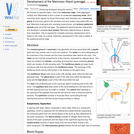
The mammary gland is a modified sweat gland that nourishes the young. It consists of the mamma and the teat. Undeveloped in both the male and female at birth, the female mammary gland begins to develop as a secondary sex characteristic at puberty.
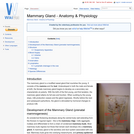
The mammary gland is a modified sweat gland that nourishes the young. It consists of the mamma and the teat. Undeveloped in both the male and female at birth, the female mammary gland begins to develop as a secondary sex characteristic at puberty.
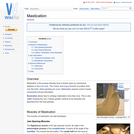
Mastication is the process whereby food is broken down by mechanical digestion in the oral cavity. The cheeks and tongue function to position food over the teeth, where grinding can occur. Mastication requires correct muscle movements and jaw articulation.
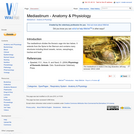
The mediastinum divides the thoracic cage into two halves. It extends from the Spine to the Sternum and contains many structures including blood vessels, nerves, oesophagus, trachea and heart.
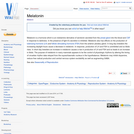
Melatonin is a hormone which is an indolamine derivative of serotonin secreted from the pineal gland into the blood and CSF in response to darkness. In the presence of light it's secretion is inhibited. Melatonin also has effects on the production of luteinizing hormone (LH) and follicle stimulating hormone (FSH) from the anterior pituitary gland. In long day breeders the increasing daylight hours cause a decrease in melatonin. In response, production of LH and FSH is uninhibited and so libido rises. In short day breeders an increase in melatonin causes a rise in production of LH and FSH and so leads to an increase in libido. The purpose of melatonin in many mammals appears to be the control of physiologic rhythms by altering the timing of circadian rhythm data relayed from the suprachiasmatic nucleus in the hypothalamus. Melatonin may inhibit dopamine, reduce free radical production and central nervous system excitability as well as augmenting GABA.
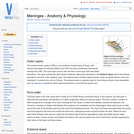
The central nervous system (CNS) is surrounded by several layers of tissue, with several outer layers not directly related to the CNS and three membranes that directly envelope the CNS. The outer layers are the skin and then a bone layer with associated periosteum. This layer includes the skull and the vertebrae. Below the periosteum is the Epidural Space which lies between periosteum and dura in the vertebral canal. The epidural space contains adipose tissue, loose connective tissue, veins and lymphatics. It cushions the cord as it flexes.
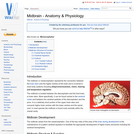
The midbrain or mesencephalon represents the connection between the brain stem and the higher centres of the brain and is involved in most body systems including sleep/consciousness, vision, hearing and temperature regulation.

The enlarged swelling of the gastrointestinal tract between the oesophagus and the duodenum is called the stomach. It is a simple structure in carnivores and a compound structure in ruminants. The stomach functions as a reservoir of food where digestion occurs through chemical and mechanical processes. This allows food to be broken down further and absorbed.
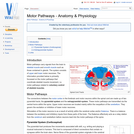
Motor pathways carry signals from the brain to skeletal muscle and smooth muscle such as those contained in glands. The system consists of upper and lower motor neurones. The information provided below is primarily focussed on the motor pathways that coordinate skeletal muscle movement, i.e. motor pathways related to voluntary control of skeletal muscles.
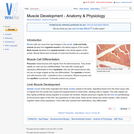
Muscle cells can come from two lineages in the somite. Limb and body muscle develop from hypaxial muscle in the lateral regions of the somite. Back muscle develops from epaxial muscle in the dorsal regions of the somite. Muscle fibres have hundreds of nuclei and function as a syncytium.
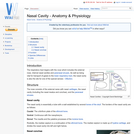
The respiratory tract begins with the nose which includes the external nose, internal nasal cavities and paranasal sinuses. As well as being vital for transport of gases to the lower respiratory tract, the nasal cavity is also the site for one of the special senses - Olfaction.

The physiology of the nervous system can be explored at the level of a nerve cell, or 'neuron'. Communication between these cells uses electrical or chemical signals known as neurotransmitters; the cellular response generated in response to this signalling is known as an action potential.
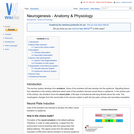
Nerves allow electrical impulses to propagate along their elongated cell extensions and facilitate the transfer of information throughout the body. Neural tissue is found within the central nervous system (CNS) and the peripheral nervous system (PNS) and the composition and constituent parts of neurones and their surrounding cells differ only slightly.
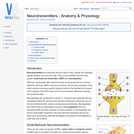
Neurotransmitters are chemicals that are used to relay, amplify and modulate signals between neurones and cells. They can be classified into two main groups; small-molecule transmitters (SMT) and neuropeptides.

Olfaction is the sense of smell, which is the ability to perceive and distinguish odours. Most mammals have a good sense of smell, but most birds generally do not. The sense of smell is well-developed in carnivores (predators) and ungulates (prey). Fish also have a fairly well-developed sense of smell. Olfactory and gustatory receptors can combine to contribute to flavour.
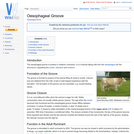
The oesophageal groove is present in newborn ruminants. It is a channel taking milk from the oesophagus into the abomasum, bypassing the rumen, reticulum and omasum.
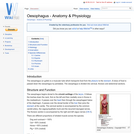
The oesophagus (or gullet) is a muscular tube which transports food from the pharynx to the stomach. A bolus of food is passed down the oesophagus by peristalsis. The oesophagus is divided into cervical, thoracic and abdominal sections.
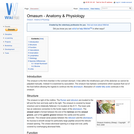
The omasum is the third chamber in the ruminant stomach. It lies within the intrathoracic part of the abdomen so cannot be palpated manually. Instead it is examined by ausculation. The omasum has biphasic contractions which squeeze fluid out of the food before allowing the ingesta to continue into the abomasum. Absorption of volatile fatty acids continues in the omasum.